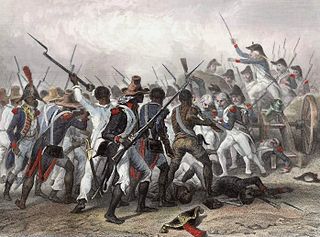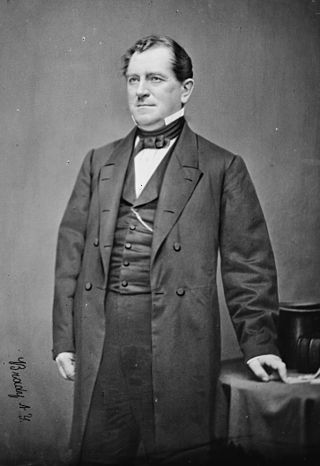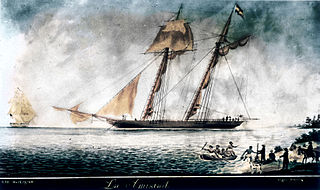Related Research Articles

Abolitionism, or the abolitionist movement, is the movement to end slavery and liberate slaves around the world.

United States v. Schooner Amistad, 40 U.S. 518 (1841), was a United States Supreme Court case resulting from the rebellion of Africans on board the Spanish schooner La Amistad in 1839. It was an unusual freedom suit that involved international diplomacy as well as United States law. The historian Samuel Eliot Morison described it in 1969 as the most important court case involving slavery before being eclipsed by that of Dred Scott v. Sandford in 1857.
David Walker was an American abolitionist, writer, and anti-slavery activist. Though his father was enslaved, his mother was free; therefore, he was free as well. In 1829, while living in Boston, Massachusetts, with the assistance of the African Grand Lodge, he published An Appeal to the Colored Citizens of the World, a call for black unity and a fight against slavery.

The American Anti-Slavery Society was an abolitionist society founded by William Lloyd Garrison and Arthur Tappan. Frederick Douglass, an escaped slave, had become a prominent abolitionist and was a key leader of this society, who often spoke at its meetings. William Wells Brown, also a freedman, also often spoke at meetings. By 1838, the society had 1,350 local chapters with around 250,000 members.

Henry Highland Garnet was an American abolitionist, minister, educator, orator, and diplomat. Having escaped as a child from slavery in Maryland with his family, he grew up in New York City. He was educated at the African Free School and other institutions, and became an advocate of militant abolitionism. He became a minister and based his drive for abolitionism in religion.

My Bondage and My Freedom is an autobiographical slave narrative written by Frederick Douglass and published in 1855. It is the second of three autobiographies written by Douglass, and is mainly an expansion of his first, Narrative of the Life of Frederick Douglass, an American Slave. The book depicts in greater detail his transition from bondage to liberty. Following this liberation, Douglass went on to become a prominent abolitionist, speaker, author, and advocate for women's rights.

The coastwise slave trade existed along the southern and eastern coastal areas of the United States in the antebellum years prior to 1861. Hundreds of vessels of various capacities domestically traded loads of slaves along waterways, generally from the Upper South which had a surplus of slaves to the Deep South where new cotton plantations created high demand for labor.

The Creole mutiny, sometimes called the Creole case, was a slave revolt aboard the American slave ship Creole in November 1841, when the brig was seized by the 128 slaves who were aboard the ship when it reached Nassau in the British colony of the Bahamas where slavery was abolished. The brig was transporting enslaved people as part of the coastwise slave trade in the American South. It has been described as the "most successful slave revolt in US history". Two died in the revolt, an enslaved person and a member of the crew.

Joshua Reed Giddings was an American attorney, politician and a prominent opponent of slavery. He represented Northeast Ohio in the U.S. House of Representatives from 1838 to 1859. He was at first a member of the Whig Party and was later a Republican, helping found the party.

The North Star was a nineteenth-century anti-slavery newspaper published from the Talman Building in Rochester, New York, by abolitionist Frederick Douglass. The paper commenced publication on December 3, 1847, and ceased as The North Star in June 1851, when it merged with Gerrit Smith's Liberty Party Paper to form Frederick Douglass' Paper. At the time of the Civil War, it was Douglass' Monthly.

La Amistad was a 19th-century two-masted schooner owned by a Spaniard living in Cuba. It became renowned in July 1839 for a slave revolt by Mende captives who had been captured and sold to European slave traders and illegally transported by a Portuguese ship from West Africa to Cuba, in violation of European treaties against the Atlantic slave trade. Spanish plantation owners Don José Ruiz and Don Pedro Montes bought 53 captives in Havana, Cuba, including four children, and were transporting them on the ship to their plantations near Puerto Príncipe. The revolt began after the schooner's cook jokingly told the slaves that they were to be "killed, salted, and cooked." Sengbe Pieh unshackled himself and the others on the third day and started the revolt. They took control of the ship, killing the captain and the cook. Three Africans were also killed in the melee.

Nat Turner's Rebellion, historically known as the Southampton Insurrection, was a rebellion of enslaved Virginians that took place in Southampton County, Virginia, in August 1831. Led by Nat Turner, the rebels killed between 55 and 65 White people, making it the deadliest slave revolt for white people in U.S. history. The rebellion was effectively suppressed within a few days, at Belmont Plantation on the morning of August 23, but Turner survived in hiding for more than 30 days afterward.

The Heroic Slave, a Heartwarming Narrative of the Adventures of Madison Washington, in Pursuit of Liberty is a short piece of fiction, or novella, written by abolitionist Frederick Douglass, at the time a fugitive slave based in Boston. When the Rochester Ladies' Anti Slavery Society asked Douglass for a short story to go in their collection, Autographs for Freedom, Douglass responded with The Heroic Slave. The novella, published in 1852 by John P. Jewett and Company, was Douglass's first and only published work of fiction.
The Liberty Party was an abolitionist political party in the United States prior to the American Civil War. The party experienced its greatest activity during the 1840s, while remnants persisted as late as 1860. It supported James G. Birney in the presidential elections of 1840 and 1844. Others who attained prominence as leaders of the Liberty Party included Gerrit Smith, Salmon P. Chase, Henry Highland Garnet, Henry Bibb, and William Goodell. They attempted to work within the federal system created by the United States Constitution to diminish the political influence of the Slave Power and advance the cause of universal emancipation and an integrated, egalitarian society.
Afro-Bahamians are an ethnicity originating in The Bahamas of predominantly or partial native African descent. They are descendants of various African ethnic groups, many associated with the Bight of Biafra, kingdoms, the Oyo Empire, and the Kingdom of Kongo. According to the 2010 census, 92.7% of The Bahamas' population identifies as mixed African descent.
The Enterprise was a United States merchant vessel active in the coastwise slave trade in the early 19th century along the Atlantic Coast. Bad weather forced it into Hamilton, Bermuda waters on February 11, 1835 while it carried 78 slaves in addition to other cargo. It became the centre of a minor international incident when the British authorities freed nearly all the slaves. Britain had abolished slavery in its Caribbean colonies effective 1834. At that time it advised "foreign nations that any slavers found in Bermuda [and the Bahamas] waters would be subject to arrest and seizure. Their cargoes were liable to forfeiture" without compensation.

In the United States, abolitionism, the movement that sought to end slavery in the country, was active from the colonial era until the American Civil War, the end of which brought about the abolition of American slavery, except as punishment for a crime, through the Thirteenth Amendment to the United States Constitution.
Hermosa was an American slave ship whose 1840 grounding in the Bahamas led to a controversy between the United Kingdom and the United States over the 38 slaves who had been on board the ship and were freed by the British authorities.

Slavery in the Bahamas dates back several centuries.
The National Convention of Colored Citizens was held August 15–19, 1843 at the Park Presbyterian Church in Buffalo, New York. Similar to previous colored conventions, the convention of 1843 was an assembly for African American citizens to discuss the organized efforts of the anti-slavery movement. The convention included individuals and delegates from various states and cities. Henry Highland Garnet and Samuel H. Davis delivered key speeches. Delegates deliberated courses of action and voted upon resolutions to further anti-slavery efforts and to help African Americans.
References
- ↑ Rodriguez, Junius P., ed. (2006). "Madison Washington". Encyclopedia of Slave Resistance and Rebellion. Vol. 1. Greenwood Publishing Group. pp. 571–572. ISBN 0-313-33272-X . Retrieved February 2, 2010.
- 1 2 3 Williams, Michael Paul (2002). "Brig Creole slaves". Richmond Times-Dispatch . Richmond, VA. Retrieved February 2, 2010.
- ↑ Garnet, Henry Highland. (1843) Henry Highland Garnet, "An Address To The Slaves Of The Corrupted United States", full text.
- ↑ Douglass, Frederick. The Heroic Slave Archived 2010-01-18 at the Wayback Machine , full text with commentary.